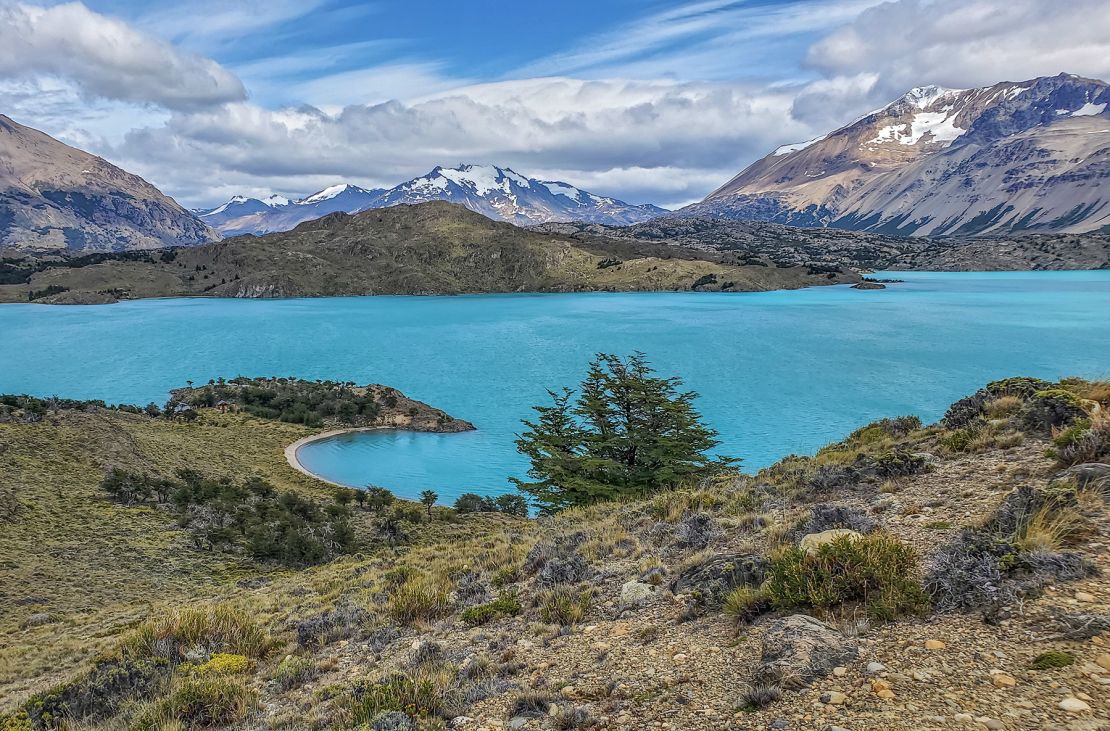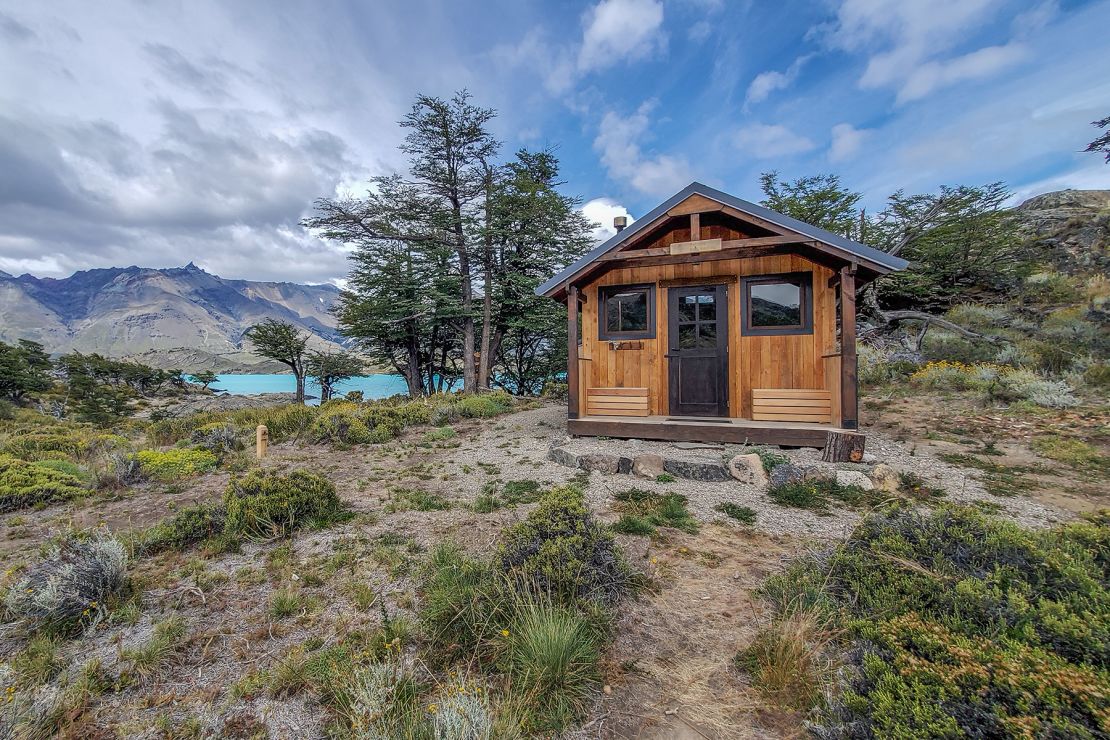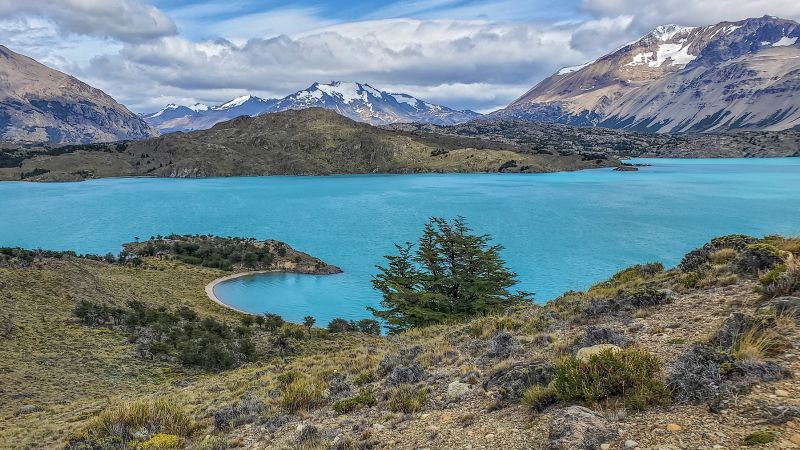The condors gave it away.
Instead of soaring in circles on thermals high overhead, a group of Andean condors was traveling low to the ground. Some even landed tentatively before lumbering back up into the air only to touch down again near the same spot near one of the dirt roads that run through the park. These endangered scavengers were clearly feeding and I wanted to see what they’d found to feast on.
As I drove slowly closer, the enormous birds moved a short distance away and after a few careful steps through tufts of grass along the side of the road I saw what they were after: a partly eaten young guanaco, its neck snapped in a signature puma move. Standing there alone with the fresh kill under the watchful, wary eyes of the condors felt like I was in my own personal episode of “Wild Kingdom” with Marlin Perkins.
I’d been traveling in the Patagonia regions of Argentina and Chile for months, so I knew that having that moment to myself in Argentina’s Perito Moreno National Park was a rare gift. The chance for wild encounters in nature has inspired more and more people to travel to Patagonia which, in turn, has made crowds more commonplace in some of the area’s most popular parks.
For example, you’ll see far more humans than Andean condors in Torres del Paine National Park. Just a few hundred miles south on the Chile side of Patagonia, Torres del Paine was visited by 304,947 people in 2019 (despite the park’s hefty entrance fee). Meanwhile, Perito Moreno National Park, which is free to enter, was visited by just 272 people in 2019 between October 1 and May 1 when the park is open to visitors. That’s an average of about one visitor per day during its seven month season.
So why is this park so lightly visited? Its remote location (even by Patagonian standards) and low profile compared to well-publicized superstar parks such as Torres del Paine keep numbers down – and that’s a boon for travelers looking for their own “Wild Kingdom” moments.
Diverse landscapes and Patagonia’s second highest peak
Perito Moreno National Park – not to be confused with Perito Moreno Glacier to the south – was named after Francisco “Perito” Moreno, an Argentinean geographer, naturalist, anthropologist and biologist who is credited with creating the country’s park system when he donated 18,500 acres to the Argentinean government to create the country’s first national park.
Perito Moreno National Park was established to protect its distinct combination of Patagonian steppe grasslands, spiky peaks (including San Lorenzo Mountain, the second highest peak in Patagonia at 12,159 feet), milky glacier-fed rivers, lakes free of invasive trout and forests of hardy, small-leafed lenga beech trees.

These diverse landscapes are home to guanacos (the llama’s wild cousin), endangered Andean condors, rarely seen pampas cats, flamingos, rheas (an ostrich-like bird), pumas, elusive Geoffroy’s cats and endangered huemul deer.
In 1990, the area’s natural riches caught the attention of Doug Tompkins, the co-founder of Esprit and an accomplished outdoor adventurer, and inspired him to purchase the El Rincón Ranch abutting the park. In 2014, his Tompkins Conservation organization donated the ranch to the Argentinean National Parks Administration in a move that added 37,000 acres to the park.
Windswept and rugged
Today, Perito Moreno National Park protects more than 313,400 acres and exploring that environment recently became easier with the addition of new infrastructure.
There are now 55 miles of hiking trails in Perito Moreno National Park. During my visit, I hiked a route called the Long Belgrano Peninsula Circuit (Belgrano Circuito Grande in Spanish) which turned into a nearly 13 mile loop because, despite good trail signage, I missed the cut off that leads directly back to the trailhead and ended up skirting around a huge hill instead.
But I wasn’t complaining as the mostly undulating trail took me through a gorgeous mix of lenga beech forests, expanses of grassy steppe and the rugged shoreline of Belgrano Lake. Even better, the only other people I saw on the trail were a family of four and two couples.
There are also nearly 60 miles of dirt roads in the park that deliver visitors to viewpoints from which to admire park landscapes. Whether you’re exploring the park on foot or in a vehicle, remember that the weather is as much a part of the Patagonian experience as the terrain or the flora or the fauna. Be ready for a range of temperatures and conditions and heed wind warnings.
For example, at the blufftop viewpoint over Volcano Lake (Laguna Volcán), rangers have placed a sign that reads “Cuidada en las dias con viento fuerte” (Be careful on the days with strong wind). They’re not kidding.
During my stop there, the famous Patagonian wind was so fuerte that I could barely open the door of my truck. Once I managed to get out, I felt like I was about to be knocked off my feet. At Mie Lagoon, which is favored by flamingos, a wooden blind serves as a lair from which to observe the birds as they defy their tropical stereotype by picking their way through the icy water in the shadow of snow-capped peaks. The blind also makes a great shelter from the wind.

You’ll need more than a day to explore all that Perito Moreno National Park offers and the recent addition of a daisy chain of 10 wood cabins (called refugios in Spanish) makes spending a night or two in the park much easier, although the cabins are temporarily closed because of the pandemic.
The cabins come in different sizes to accommodate three to six people and even if you don’t think you’re a sleep-in-the-park type, they’re tempting – and free. All have bunk beds with mats (BYO sleeping bag), high-quality windows (no drafts), wood-burning stoves (and well-stocked wood piles), a basic cooking/dining/sitting area (BYO cooking stove and food), porches with lake views and nearby bio outhouses.
To encourage further use of the cabins, a hut-to-hut network of trails called Hidden Lakes (Lagos Escondidos) was created to allow hikers to explore the park with nights spent in cabins along the way. Camping is also an option in small lakeside campgrounds with smooth, flat tent spots and bio outhouses. Two backcountry camping areas serve visitors who want to explore more remote areas such as San Lorenzo Mountain.
No matter how you choose to explore Perito Moreno National Park, you’ll likely have the experiences and the solitude that drew you to Patagonia in the first place.
Perito Moreno National Park is open from October 1 through the end of April.
Pandemic travel restrictions are currently in place across Argentina because travel increases your risk of contracting and transmitting the virus. But this park is full of fresh air and likely to be free of crowds when the world starts traveling internationally in large numbers again.
Park entrance is free as is use of the cabins (once they reopen post-Covid) and campsites. Overnight stays in cabins or camping areas require reservations. Go to this link, and use the “Huts & annex tent sites” tab under the “Where to Sleep” tab to select the cabin or camping area you want to reserve. There’s a two night maximum in most cabins.
You will need your own vehicle to reach and explore Perito Moreno National Park, which is accessed via Ruta Provincial 37, a rough 50-plus mile dirt road that cuts off Argentina’s iconic Ruta Nacional 40 that runs the length of the country. Allow at least an hour and a half on RP 37 to get to the park entrance and ranger station.
A 4×4 is not necessary, but good tires and decent ground clearance are. Be sure you have a full tank of gas and bring extra if you think you might exceed your tank’s mileage. There is no fuel available in or near the park.
Don’t confuse Perito Moreno National Park with the Perito Moreno Glacier (also named for Francisco “Perito” Moreno). The popular glacier is located near the town of El Calafate, hundreds of miles from Perito Moreno National Park.
If you don’t feel like camping or staying in a cabin, you can still sleep inside Perito Moreno National Park by booking accommodations at Estancia La Oriental where the hospitable Lada family have turned their sheep ranch farmhouse into a homey and history-filled guesthouse.
Read the full article here


